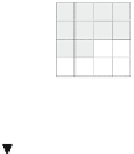Graphics Reference
In-Depth Information
b
i
−1
Context
Memory
adaptive prob. estimation
context
derivation
A
(
i
−1,
t
)
p
LPS
=
F
(
b
,
v
(
MPS
i
−
1
t
−
1
,
p
(
LPS
i
−
1
t
−
1
)
i
−
1
b
i
L
(
MPS
i
,
t
)
b
i
⊕
v
Probability
Estimator &
Assigner
Regular
Arithmetic
Encoder
b
i
syntax
element
(
LPS
i
,
t
)
p
Mux
bin-by-bin
processing
(
b
1
,
b
2
,...,
b
n
)
regular/bypass
mode switch
Binarizer
b
j
Bypass
Arithmetic
Encoder
p
=0.5
serial processing
of bins
Fig. 8.1
CABAC block diagram (from the encoder perspective): Binarization, context modeling
(including probability estimation and assignment), and binary arithmetic coding. In
red
: Potential
throughput bottlenecks, as further discussed from the decoder perspective in Sect.
8.3.2
based on the usage of context-adaptively switched sets of variable-length codes, so-
called Context-Adaptive Variable-Length Coding (CAVLC). Compared to CABAC,
CAVLC offers reduced implementation cost at the price of lower compression
efficiency. Typically, the bit-rate overhead for CAVLC relative to CABAC is in
the range of 10-16 % for standard definition (SD) interlaced material, encoded at
Main Profile, and 15-22 % for high definition (HD) 1080p material, encoded at
High Profile, both measured at the same objective video quality and for the case that
all other used coding tools within the corresponding H.264/AVC Profile remain the
same [
46
,
48
].
CABAC became also part of the first HEVC test model HM1.0 [
53
] together with
the so-called low-complexity entropy coding (LCEC) as a follow-up of CAVLC.
Later, during the HEVC standardization process, it turned out that to improve the
compression efficiency of LCEC, the complexity of LCEC had to be increased
to a point where LCEC was not significantly lower complexity than CABAC.
Thus, CABAC in its improved form, both with respect to throughput speed and
compression efficiency, became the single entropy coding method of the HEVC
standard.
The basic design of CABAC involves the key elements of binarization, context
modeling, and binary arithmetic coding. These elements are illustrated as the main
algorithmic building blocks of the CABAC encoding block diagram in Fig.
8.1
.
Binarization maps the syntax elements to binary symbols (bins). Context modeling
estimates the probability of each non-bypassed (i.e., regular coded) bin based on
some specific context. Finally, binary arithmetic coding compresses the bins to bits
according to the estimated probability.






























